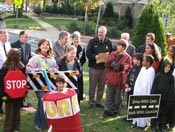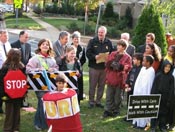
All In a Night's Work
Halloween night is full of frightening hazards, many of them real.
- By Marc Barrera
- Oct 01, 2008
 October's final night is much darker than the harmless fun you may imagine. Ghosts and goblins may be prowling the streets with witches, warlocks, princesses, pirates, and countless other costumed carousers, minds fixed on sweets and treats. The truth is, they have good reason to be frightened.
October's final night is much darker than the harmless fun you may imagine. Ghosts and goblins may be prowling the streets with witches, warlocks, princesses, pirates, and countless other costumed carousers, minds fixed on sweets and treats. The truth is, they have good reason to be frightened.
Every year, about 44 percent of the U.S. highway deaths on Halloween night (6 p.m., Oct. 31 to 5:59 a.m., Nov. 1) involve a driver or motorcyclist whose blood alcohol concentration is 0.08 or higher, which is illegal in every state, according to the National Highway Traffic Safety Administration. The U.S. Centers for Disease Control and Prevention's National Center for Injury Prevention reports pedestrian fatalities are 4.5 times higher during Halloween. Falls, open flames, and dark clothing are additional hazards. To ensure the night is not a true horror tale, a little planning is in order.
Costumes: Fire Safety and Visibility
Largely gone are the days of making your own costume, which is not necessarily a bad thing; store-bought costumes come with many safety features built in.
Lit candles inside jack-o'-lanterns can set a costume alight when an unsuspecting child brushes past it. When picking out a costume, check the tag to see whether its material is fireproof or fire retardant. Also, make sure the costume can be easily removed should it catch on fire. Regardless whether the outfit uses a zipper(s) or buttons, they should be located in the front for easy access in case of an emergency. Make sure children know to "stop, drop, and roll" if their costume should catch on fire.
The U.S. Consumer Product Safety Commission recommends that consumers look for costumes that have reflective material. If one is not available, purchase reflective tape and add it to the costume; if this would ruin the look of the costume, get a reflective candy bag or decorate the one you have with reflective tape.
Do the same thing if you do make your own costume: Use flame-resistant and high-visibility materials, and make sure it can be easily removed. Fit is very important in a Halloween costume. CPSC recommends making sure the costume is large enough for the child to wear it over clothing on a cold night but snug enough to prevent snagging. The costume must be short enough to be clear of the child's feet to prevent tripping. In a discreet place on the child's costume, such as inside the costume's collar, attach emergency identification information: name, address, and phone number. Children should wear well-fitting, sturdy shoes to further prevent falls.
Halloween flashlights are popular with children; have them pick out their own so they'll keep it with them while trick-or-treating. Glow sticks are also popular, and they can be worn around the neck or tied to a candy sack.
Vision Protection
Eye hazards abound during trick-or-treating. Steer clear from costume props that include simulated knives, swords, or anything else that could pose a eye hazard. If a compromise must be made, make sure the props are soft and flexible enough to mitigate the hazard.
Masks are not recommended because they can further limit a child's already limited night vision. If a mask must be worn, make sure the eye holes are large enough so they do not limit the child's peripheral vision. Face makeup that is specially made for the occasion is recommended as an alternative to masks by the U.S. Food and Drug Administration, which offers these tips:
• Follow all directions carefully.
• Don't decorate your face with things that aren't intended for your skin.
• Like soap, some things are okay for your skin, but not in your eyes. Some face paint or other makeup may say on the label that it is not for use near the eyes. Believe this, even if the label has a picture of people wearing it near their eyes. Be careful to keep the makeup from getting into your eyes.
• Even products intended for use near your eyes can sometimes irritate your skin if you use too much.
• If you're decorating your skin with something that you've never used before, you might try a dab of it on your arm for a couple of days to check for an allergic reaction before you put it on your face. This is an especially smart thing to do if you tend to have allergies.
FDA regulates the color additives that can be used in such face paint makeup. Be sure to check the ingredients label for the name of the colors and cross reference them with the agency's online Summary of Color Additives. Among the approved colors on the list are fluorescent and luminescent colors that will make your ghoul more visible; however, none of the paints are approved for use near the eyes.
When the night's fun is over, make sure to follow the manufacturer's instructions for paint removal: Use soap and water if recommended, and use cold cream if it is recommended. Do not allow your child to go to bed with the makeup up on because it may irritate the skin and cause a rash.
Illegal decorative contact lenses are a recurring hazard for older trick-or-treaters. Every year, FDA reports, these lenses have been distributed directly to consumers--without the appropriate involvement of a qualified eye care professional--through sources such as beauty salons, flea markets, convenience stores, beach shops, and the Internet. Reported risks from their use include corneal ulcers, conjunctivitis, corneal edema, allergic reactions, and corneal abrasion due to poor lens fit. In extreme cases, permanent loss of vision results from their use. They also can pose a threat to pedestrians because they can impair a wearer's vision while driving.
Traffic Safety
Before trick-or-treating, it's wise to plan your route. It is recommended that trick-or-treaters stay in their local neighborhoods where they are more familiar with their surroundings. A parent or responsible adult should accompany any outing of children under 12 years old. Set a curfew for older children going out on their own. Make sure all children know how to call home or 911 if they become separated or lost.
Tell children to stick only to well-lit houses, stay in a group and to the established route, and always use the sidewalk. If one is not available, walk at the farthest edge of the street facing traffic. Other recommendations:
• Cross the street only as a group and in established crosswalks.
• Remove masks or any items that limit eyesight before doing crossing.
• Do not cross between parked cars or though alleyways or yards.
The National Safety Council asks motorists to be especially alert on Halloween and provides these tips:
• Watch for children darting out from between parked cars.
• Watch for children walking on roadways, medians, and curbs.
• Enter and exit driveways and alleys carefully.
• At twilight and later in the evening, watch for children in dark clothing.
When passing through residential neighborhoods, drivers should slow down and drive at least 5 mph below the speed limit to give themselves enough reaction time to avoid excited trick-or-treaters who might dart into the street. If driving during the evening, scan your surroundings, including looking to your left and right into yards and onto porches. Be patient and take your time. If you are familiar with alternative routes that will take you around rather than through busy neighborhoods, use them. When passing cars pulled over to the curb, be on the lookout: They may belong to parents transporting their kids from house to house, and the vehicles may block your view of children who are running from the vehicle toward a house across the street. Parents who are transporting their children in such a way are advised to have children exit the vehicle only on the side that is facing the curb.
If a Halloween party is your destination, plan ahead because state and local officers will be out in full force, cracking down on drunk drivers with an aggressive "Drunk Driving. Over the Limit. Under Arrest." enforcement blitz. To help keep the roadways safe and ensure Halloween party-goers don't spent the night in a jail cell, "Stop Impaired Driving" offers these safety tips:
• Plan a safe way home before the festivities begin.
• Before drinking, designate a sober driver and give that person your keys.
• If you're impaired, use a taxi, call a sober friend or family member, or use public transportation so you are sure to get home safely.
• Look up and use any local "Sober Rides" program.
• If you happen to see a drunk driver on the road, don't hesitate to contact your local law enforcement.
Food Safety
FDA recommends that parents remind children not to snack while trick-or-treating. To further ensure compliance, parents should prepare an early meal for their kids so they aren't hungry when they receive candy. Tell them not to accept anything that isn't commercially wrapped.
Parents should discard home-made candy or baked goods that aren't from friends or relatives. Parents of young children also should remove any choking hazard, such as gum, peanuts, hard candies, or small toys. Inspect candy for any sign of tampering, including tears, discoloration, or tiny pinholes. And, remember, if in doubt, throw it out.
Children with food allergies or diabetes do not have to miss out on the fun. Parents can replace their candy haul with pre-bought store items, such as toys or games. Local party supply stores have various low-cost trinkets that can be bought in bulk, such as yo-yos and temporary tattoos.
Safer Alternatives
Despite every precautionary measure that can be taken, nothing trumps avoidance. Safer alternatives for those wishing to avoid the streets include going to local malls and participating in Halloween night activities there. Local neighborhood associations often plan Halloween parties at nearby parks, where they host games and contests and give away safe candies. Churches frequently host fall festivals or carnivals in church parking lots on Halloween night.
Whatever your plans, making safety your top priority can ensure the night isn't filled with terror.
This article originally appeared in the October 2008 issue of Occupational Health & Safety.